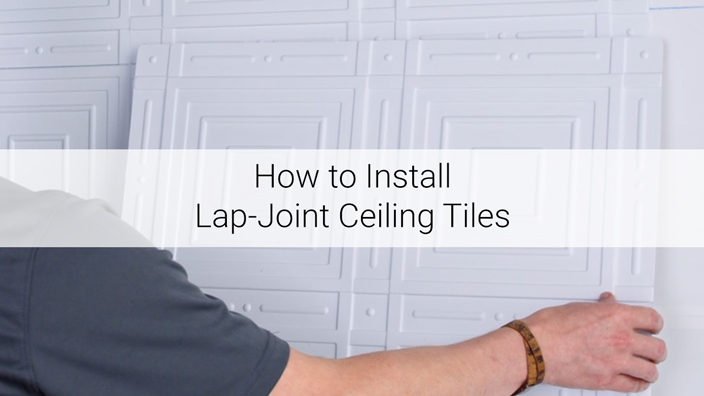How to Install Lap Joint Ceiling and Wall Tiles
Lap joint tiles are mounted directly to a sound installation surface using adhesive. These styles have unique overlapping edges which make them simple to align and install, and require no extra pieces or accessories to cover the seams between tiles.
Check building codes as required.
Plan Your Ceiling/Wall Layout
We love the proverb "measure twice, cut once." It's important to accurately map out your installation and double-check your layout before cutting tiles and permanently affixing them!
Draw a layout of your installation surface. Measure and mark the locations of your walls, hallways, closets, doorways, lights, vents, speakers, fans, and other fixtures.
Once you have a basic plan, decide how you want to lay out your lap-joint tiles. In some cases, you may want to start at a location that will minimize the number of tiles being trimmed. In others, it may be desirable to center tiles around important fixtures or other features. It's really up to you!
Temperature Warning
As a guideline, Ceilume lap-joint tiles are not affected by ceiling/wall temperatures up to 120°F. In some installations involving halogen lights, metal heat registers, or other heat sources (stoves, ovens, etc.), localized ceiling/wall temperatures can be much higher than anticipated. Please contact us for advice if your installation involves any of these special conditions.
Prepare Your Installation Surface
Your installation surface must be flat, clean, and firm or your new lap-joint tiles won't adhere properly. You'll need to remove ceiling/wall texture (e.g. popcorn), and patching and sanding may be necessary if your installation surface is damaged or uneven.
Clean Your Room
Lap-joint tiles may come out of the box with a slight static charge, which can attract dust and debris from construction and remodeling. We strongly advise that you finish all sawing, drilling, sanding, and sweeping, and thoroughly clean your room before installing your tiles. Don't worry, our tiles don't create dust of their own, and once installed any static charge will dissipate.
Your hands, work surfaces, and installation surface must be clean and dry. Dust, oil, old paint, and other contaminants can interfere with the adhesion of lap-joint tiles, so be thorough!
Mark Your Starting Location
Referring back to your installation layout, double and triple-check it for accuracy. Then snap two perpendicular chalk lines, forming a cross at your starting location. Keep in mind that rooms are rarely perfectly square and chalk lines may need to be adjusted.
After double checking that your lines are straight and properly positioned, it's time to break out the adhesive!
Install Your Tiles
When applying adhesive, remember that more isn't necessarily better. It's about using the right amount in the right places.
To start, apply a thin bead of adhesive along the perimeter and down the center of the back of your first tile. Add an additional bead of adhesive in the center of each major design feature that will make contact with your installation surface.
Next, position your tile about 1/4 in. from your chalk lines and press it against your installation surface using light to medium pressure. Then slide the tile into place against the chalk lines, allowing the adhesive to spread. Press and rub firmly over the glued areas to smooth out any bumps in the adhesive and to seat the tile into place.
Once your first tile is installed, apply adhesive to your second tile and tilt it into place, overlapping the edge pattern of the second tile with that of the first. As you press the tile into place, wiggle it a bit to allow the adhesive to spread and to encourage the tiles to nest together. Press and rub firmly over the glued areas, then spend an extra 15 seconds or so holding down the corners where the tiles overlap.


Repeat this process with your remaining tiles, proceeding from one tile to the next adjacent tile.
As you move along, use a soft, damp rag to wipe up any excess adhesive while it's still fresh.
When you reach areas where less than full-size tiles are required, simply measure from the edge of installed tiles to the wall (make sure to take the overlapping edges into account), then cut your tiles to size with scissors or snips. Adhere the trimmed tiles to your installation surface with the cut edges toward the wall.
Maintenance
-
Painting
All non-laminated Ceilume lap-joint tiles can be painted before or after installation.
For best results:
- Make sure that everything is clean and dry
- Do not use solvent-type thinners or cleaners
- Experiment on a sample before working on your ceiling in its entirety
Painting precautions:
- Ceilume cannot guarantee that the published fire safety ratings and product specifications, certifications, listings, and approvals will remain the same after painting. Therefore, field painting will void the warranty.
- Ceiling tiles and panels being used in a drop-out installation MUST NOT BE PAINTED. Painted tiles and panels are prohibited from use beneath ceiling fire suppression sprinklers.
-
Cleaning
Ceilume lap-joint tiles require no special cleaning agents - just wipe them down with a soft, damp rag. Small, stubborn spots can be handled with mild soap, and tiles are 100% waterproof so there is no risk of water damage during cleaning!
Do not use cleaners containing organic solvents or other aggressive ingredients as they may affect the surface appearance of your tiles and accessories. Examples of these types of cleaners include chlorine bleach, liquid grease remover, strong detergents, and nail polish remover.
-
Storing
Store any extra boxes of ceiling tiles upright in a single layer (do not stack). Choose a cool spot out of direct sunlight.
We Are Here to Help!
We hope that the information above is clear and provides the answers to any questions you may have along the way, but if it does not, please do not hesitate to contact us directly for help.
- Hours: 8:00 AM - 4:30 PM, Pacific Time
- Phone: 1-800-557-0654
- Email:





